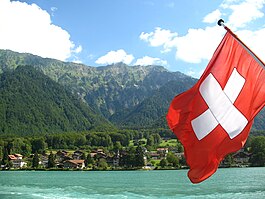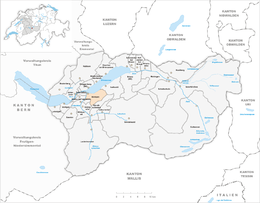Bönigen
| Bönigen | ||
|---|---|---|

Bönigen from Lake Brienz
|
||
|
||
| Coordinates: 46°41′N 7°53′E / 46.683°N 7.883°ECoordinates: 46°41′N 7°53′E / 46.683°N 7.883°E | ||
| Country | Switzerland | |
| Canton | Bern | |
| District | Interlaken-Oberhasli | |
| Government | ||
| • Mayor | Hans Nyffenegger | |
| Area | ||
| • Total | 15.12 km2 (5.84 sq mi) | |
| Elevation | 568 m (1,864 ft) | |
| Population (Dec 2015) | ||
| • Total | 2,522 | |
| • Density | 170/km2 (430/sq mi) | |
| Postal code | 3806 | |
| SFOS number | 0572 | |
| Surrounded by | Iseltwald, Gündlischwand, Gsteigwiler, Matten bei Interlaken, Wilderswil, Interlaken | |
| Website |
www SFSO statistics |
|
Bönigen is a village and municipality in the Interlaken-Oberhasli administrative district in the Swiss canton of Bern. It lies on the shore of Lake Brienz, near to the mouth of the river Lütschine, and adjacent to the resort town of Interlaken.
Bönigen belongs to the Small Agglomeration Interlaken with 23,300 inhabitants (2014).
Bönigen belongs to the church parish of Gsteig bei Interlaken, which includes eight other nearby municipalities.
Bönigen is first mentioned in 1261 as villa Boningen. The name Bönigen ("of the people of the Bono clan") is composed of the Old High German personal name Bono and the toponymic suffix -ingun.
The village was first mentioned in 1261 then the Freiherr of Eschenbach gave part of the village to Interlaken Abbey. He gave the Abbey additional lands in the village in 1275., the 1261 and 1275 it gave with Iselten and Künzlenalp the Interlaken monastery. Throughout its history, Bönigen was often at the center of unsuccessful conflicts in the Bernese Oberland. In 1330, the Oberhasli valley rebelled against their overlord in what came to be known as the Weissenburger War. The Oberhasli army was destroyed outside Bönigen. About two decades later, in 1349, Bönigen joined an unsuccessful rebellion against the growing power of Interlaken Abbey. In 1528, Bern adopted the Protestant Reformation and ordered all the surrounding districts to convert to the new faith. Bönigen joined the unsuccessful Oberland resistance to this conversion. Once Bern had enforced its will on the Oberland, they secularized Interlaken Abbey and annexed all the Abbey's land. Bönigen became part of the Bernese bailiwick of Interlaken. Following the 1798 French invasion, Bönigen became part of the Helvetic Republic Canton of Oberland. The new Canton only lasted a few years and was reintegrated into the Canton of Bern with the Act of Mediation in 1803. In 1814 and again in 1836, Bönigen led attempts to recreate the Canton of Oberland.
...
Wikipedia



